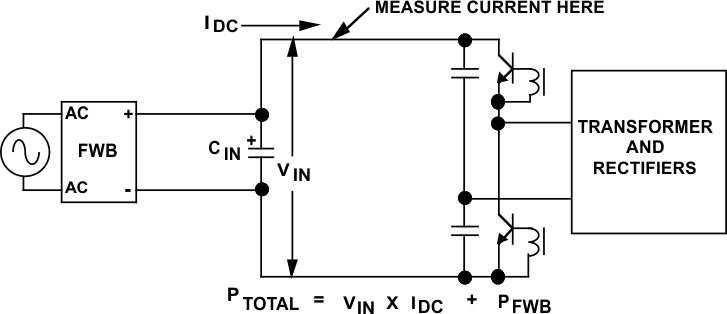SNVA559C September 2012 – February 2019 LM2574 , LM2575-N , LM2575HV , LM2576 , LM2576HV , LM2577
-
Switching regulator fundamentals
- Trademarks
- 1 Switching Fundamentals
- 2 Switching Converter Topologies
- 3 Application Hints for Switching Regulators
- 4 Application Circuits
- 5 References and Related Products
- Revision History
3.6 Measuring Regulator Efficiency of Offline Converters
Offline converters are powered directly from the AC line, by using a bridge rectifier and capacitive filter to generate an unregulated DC voltage for conversion (see Figure 13 and Figure 14).
Measuring the total power drawn from the AC source is fairly difficult because of the power factor. If both the voltage and current are sinusoidal, power factor is defined as the cosine of the phase angle between the voltage and current waveforms.
The capacitive-input filter in an offline converter causes the input current to be very non-sinusoidal. The current flows in narrow, high-amplitude pulses (called Haversine pulses) which requires that the power factor be redefined in such cases.
For capacitive-input filter converters, power factor is defined as:
The real power drawn from the source (PREAL) is the power (in Watts) which equals the sum of the load power and regulator internal losses.
The apparent power (PAPPARENT) is equal to the RMS input current times the RMS input voltage. Rewritten, the importance of power factor is shown
The RMS input current that the AC line must supply (for a given real power in Watts) increases directly as the power factor reduces from unity. Power factor for single-phase AC-powered converters is typically about 0.6. If three-phase power is used, the power factor is about 0.9.
If the efficiency of an offline converter is to be measured, power analyzers are available which will measure and display input voltage, input power, and power factor. These are fairly expensive, so they may not be available to the designer.
Another method which will give good results is to measure the power after the rectifier bridge and input capacitor (where the voltage and current are DC). This method is shown in Figure 24.
 Figure 24. Measuring Input Power in Offline Converter
Figure 24. Measuring Input Power in Offline Converter The current flowing from CIN to the converter should be very nearly DC, and the average value can be readily measured or approximated (see previous section).
The total power drawn from the AC source is the sum of the power supplied by CIN (which is VIN × IDC) and the power dissipated in the input bridge rectifier. The power in the bridge rectifier is easily estimated, and is actually negligible in most offline designs.